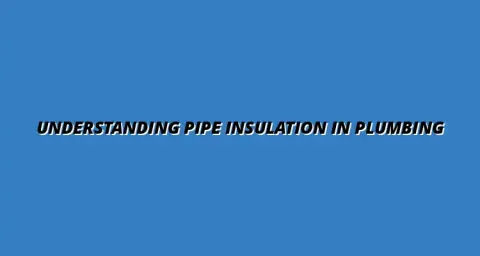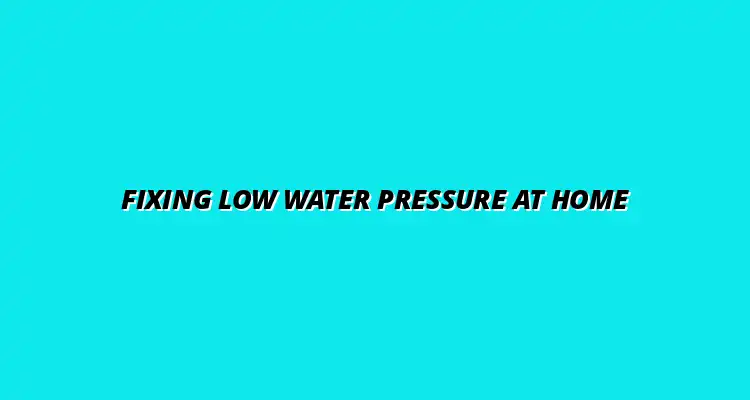
- Plumbing Basics
- Feb 14
2025-02-08
Low water pressure can be a frustrating issue for many homeowners. It refers to the reduced force of water coming out from taps, showers, and appliances. Understanding what constitutes low water pressure and its implications is the first step in addressing this common problem.
When the water pressure is lower than normal, it can lead to various inconveniences, such as slow-filling bathtubs or difficulty using multiple faucets at once. Knowing the symptoms is crucial, as these can indicate underlying problems with your plumbing system. Let’s dive into the specifics!
So, what exactly is low water pressure? Generally, it is considered low when the water pressure falls below 40 PSI (pounds per square inch). Many homes experience ideal water pressure levels between 45 to 60 PSI. When your pressure falls below this range, it can affect your daily routines and even lead to damage in some cases.
The implications of low water pressure can range from minor annoyances to serious plumbing issues. It can make simple tasks like showering or washing dishes time-consuming, and if left unchecked, it might lead to costly repairs in your home plumbing system. For a helpful guide on understanding water pressure in plumbing, check out this resource: Understanding Water Pressure in Plumbing.
To further understand low water pressure, let’s look at some benchmarks:
When you notice your water pressure is consistently below these levels, it's time to investigate further. This can help you not only improve your comfort but also protect your plumbing system from potential damage.
Recognizing the signs of low water pressure is essential for timely intervention. Here are some common symptoms you might encounter:
If you notice any of these symptoms, it's crucial to take action. They might indicate underlying problems that need your attention! Learning how to easily check your water pressure can be a great first step. See this helpful guide: Check Your Water Pressure Easily.
Now that we understand low water pressure and its implications, let’s explore what can cause this issue. Identifying the root cause is vital for finding the right solutions. Low water pressure can stem from problems within your plumbing system or external factors affecting your water supply.
By pinpointing the cause, you’ll be in a better position to take action and restore your home’s water pressure to optimal levels. Let’s break down the possible causes!
Internal plumbing issues are often the culprits behind low water pressure. This can include problems like clogged pipes or leaky fixtures. Understanding these issues can help you address them effectively.
Clogged pipes can significantly reduce water flow in your home. Common causes include:
To resolve clogged pipes, you can use methods such as chemical cleaners, drain snakes, or even professional plumbing services if the problem persists. For tips on fixing sudden water pressure drops, a common issue related to clogs, see this guide: Fixing Sudden Water Pressure Drops.
Another common issue is leaky fixtures and connections, which can waste water and lead to lower pressure. Check areas like:
Addressing leaks promptly can not only help restore your water pressure but also save you money on your water bill! Consider these water-saving plumbing tips to further improve efficiency: Water Saving Plumbing Tips.
Sometimes, the causes of low water pressure aren’t even in your home! External factors can also play a significant role. Understanding these can help you determine whether the issue is within your control or not.
If your neighbors are also experiencing low water pressure, it could be related to problems with the municipal water supply. Issues like:
In these cases, reaching out to your local water utility can provide insights and updates on the situation.
Seasonal changes can also impact water pressure, particularly during the summer months when demand is higher. For instance, dry spells can lead to reduced supply availability. Here’s what to keep in mind:
Being aware of these seasonal dynamics can help you prepare for fluctuations in water pressure throughout the year.
Now, let’s talk about how to check your water pressure at home. Measuring your water pressure is an essential step in identifying the issue and determining the best course of action. It’s relatively easy and can be done with a simple pressure gauge!
To measure your water pressure, follow these easy steps:
This will give you a clear idea of whether your water pressure is within the normal range or if further action is needed. If you're struggling to fix your low water pressure, you can find simple DIY tips here: Fix Low Water Pressure Easily.
As mentioned earlier, optimal water pressure typically ranges from 45 to 60 PSI. If your reading shows less than 40 PSI, you are likely experiencing low water pressure.
Understanding these levels helps you gauge the urgency of the situation and decide on the right steps to resolve it. Keeping track of your water pressure can ensure your home stays comfortable and functional!
When dealing with low water pressure, it’s important to think about long-term solutions that can enhance your plumbing system. These solutions not only address the immediate issue but also make your system more efficient and less prone to future problems. By upgrading certain elements of your plumbing, you can enjoy consistent water pressure and improve overall functionality!
In this section, we will explore various approaches, from upgrading your plumbing system to seeking help from professional plumbers. Each option has unique benefits, depending on the specific challenges you face in your home.
One of the most effective ways to tackle low water pressure is to consider upgrading your plumbing system. This can involve replacing certain pipes or fixtures that may be outdated or damaged. Understanding when to make these upgrades can save you a lot of hassle in the long run.
There are a couple of factors to keep in mind when contemplating a plumbing upgrade:
Knowing when to replace your pipes is critical. Consider replacements if you notice any of the following signs:
Timing for these upgrades can also depend on the age of your home and plumbing system, so it's good to stay vigilant!
When replacing pipes, selecting the right material is essential for durability and efficiency. Here are a few common options:
Each material has its pros and cons, so consider factors like cost, installation, and future maintenance when making your choice!
While some plumbing issues are manageable on your own, there are times when it’s best to consult with a professional plumber. They possess the skills and experience to identify underlying problems that you may not see. Getting expert help can save you time and money in the long run! For example, if you need a plumber in Billesley, Birmingham, you can find a reliable service here: Plumber in Billesley, Birmingham.
Here are situations when seeking professional assistance is advisable:
Understanding when to call a plumber can make a huge difference. Signs that indicate expert help might be needed include:
Taking prompt action can prevent minor issues from becoming major headaches!
Selecting a trustworthy plumbing service is crucial. Look for professionals who offer:
It’s worth taking the time to find a plumbing service that fits your needs and can provide long-lasting solutions! Addressing low water pressure in your water heater is a specialized task; consult this guide for help: Fixing Low Water Pressure in Heaters.
Once you’ve addressed low water pressure issues, it’s essential to keep your plumbing in top shape. Regular maintenance can prevent future problems and keep your water flowing smoothly. Let’s look at some practical tips for maintaining optimal water pressure!
Establishing a maintenance routine not only helps in early detection of issues but also prolongs the life of your plumbing system.
Staying proactive is the key to maintaining water pressure. Here are some regular maintenance tips every homeowner should consider:
Forming a regular check-up routine can help catch problems early. Make it a habit to:
This proactive approach can save you headaches and costs in the future!
Keeping track of your water quality and pressure levels is crucial. Here are some tips to ensure everything is running smoothly:
By staying on top of these factors, you’ll help maintain both water pressure and overall water quality!
Many homeowners have questions about low water pressure. Here are some of the most common FAQs to clear up any confusion!
Sudden drops in water pressure can be alarming. Common reasons include:
Identifying the cause quickly can help you resolve the issue faster!
To determine if low water pressure stems from plumbing problems, consider:
These steps can help you pinpoint whether it’s a plumbing issue or something else!
In summary, managing low water pressure is all about taking the right steps and being proactive. From long-term solutions to regular maintenance, there are plenty of ways to ensure your plumbing system operates effectively!
Let’s recap the key steps you can take:
By implementing these strategies, you can enjoy better water pressure and a more efficient plumbing system. Remember, early detection and maintenance are your allies in managing these issues!
If you’re facing low water pressure, don’t wait! Taking action now can improve your home’s plumbing and enhance your daily life. Stay informed, stay proactive, and ensure that your water pressure remains optimal!
